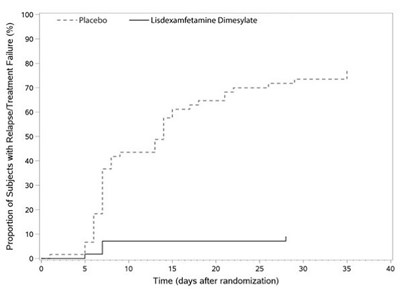Product Images Lisdexamfetamine Dimesylate
View Photos of Packaging, Labels & Appearance
Product Label Images
The following 15 images provide visual information about the product associated with Lisdexamfetamine Dimesylate NDC 0480-9744 by Teva Pharmaceuticals, Inc., such as packaging, labeling, and the appearance of the drug itself. This resource could be helpful for medical professionals, pharmacists, and patients seeking to verify medication information and ensure they have the correct product.
1 - image 10

This is a product label for Teva Lisdexamfetamine Chewable Tablets, each containing 10mg of Lisdexamfetamine dimesylate, equivalent to 5.8 mg of Lisdexamfetamine. The instructions advise chewing the tablets completely before swallowing and not to swallow them whole. The medication should be stored at 20 to 25°C with excursions permitted between 15 to 30°C. It is recommended to dispense in a light-resistant container and keep out of reach of children. Manufactured by Teva Pharmaceuticals in Parsippany, NJ. The accompanying Medication Guide should be dispensed to each patient.*
1 - image 11

This text provides information about Lisdexamfetamine Dimesylate Chewable Tablets, containing 20 mg of Usdexamfetamine dimesylate per tablet. It instructs to chew the tablets completely before swallowing and not to swallow them whole. The medication guide should be provided to each patient. The dosage information can be found in the package insert. The tablets should be stored at a temperature between 20° to 25°C. The manufacturer is Teva Pharmaceuticals based in Parsippany, NJ, 07054.*
1 - image 12

This is information related to a medication called Lisdexamfetamine Dimesylate Chewable Tablets. These tablets need to be chewed completely before swallowing and should not be swallowed whole. The pack includes 100 chewable tablets, with each tablet containing 30 mg of Lisdexamfetamine dimesylate (equivalent to 17.3 mg of Lisdexamfetamine). The prescription should be accompanied by the Medication Guide when dispensed by the pharmacist to each patient. The storage conditions recommend storing between 20 to 25°C (68° to 77°F), with excursions allowed between 15° to 30°C (59° to 86°F). The manufacturer is Teva Pharmaceuticals based in Parsippany, NJ.*
1 - image 13

This is a description of a medication called Lisdexamfetamine Dimesylate Chewable Tablets, with each tablet containing 40 mg of Lisdexamfetamine dimesylate. It is recommended to chew the tablets completely before swallowing and not swallow them whole. The pharmacist should dispense a medication guide to each patient. The dosage information can be found in the package insert. The tablets should be stored at 20° to 25°C (68° to 77°F), with excursions permitted between 15° to 30°C (59° to 86°F). The medication should be kept in a light-resistant container and out of reach of children. This medication is manufactured by Teva Pharmaceuticals.*
1 - image 14

This text contains information on Lisdexamfetamine Dimesylate Chewable Tablets, including dosage instructions, storage recommendations, and manufacturer information. It emphasizes the importance of chewing the tablets completely before swallowing and provides details on the active ingredients in each tablet. Additionally, it reminds pharmacists to dispense the medication guide to each patient. The text also includes the NDC number and quantity of tablets (100 Chewable Tablets) in the package.*
1 - image 15

This text provides information about a medication called lisdexamfetamine, which comes in the form of chewable tablets with a dosage of 60mg. It also includes instructions to chew the tablets before swallowing and to dispense the accompanying Medication Guide to each patient. The text emphasizes storing the medication at a temperature between 20°C to 25°C and keeping it out of the reach of children. It mentions the manufacturer as T3 Pharmaceuticals located in Parsippany, NJ. Further dosage information can be found in the package insert.*
1 - image 2

This text appears to be outlining special population categories, including gender (male/female) and age groups (>=75 years), as well as renal impairment levels including mild, moderate, severe, and end-stage renal disease. It also mentions PK (pharmacokinetics) with fold change and a 90% confidence interval. The text appears to be related to comparing changes in different conditions relative to a reference.*
1 - image 3

This text appears to contain information related to changes in pharmacokinetic parameters for different drugs, such as Cmax (maximum concentration) and AUC (area under the curve). The text indicates comparisons between different drugs such as Guanfacine, Venlafaxine, and Omeprazole. It also mentions "Change relative to reference."*
1 - image 4

This appears to be a list documenting drug interactions with various substrates of cytochrome P450 (CYP) enzymes. The text mentions drugs like Guanfacine, Venlafaxine, Caffeine, Dextromethorpham, Omeprazole, and Midazolam along with the corresponding enzymes they interact with. Cmax and AUC are also mentioned, indicating pharmacokinetic parameters such as maximum concentration and area under the curve. The document may provide data on the fold change and 90% confidence intervals relative to a reference value.*
1 - image 5

This text provides a table showing the LS Mean (SE) SKAMP Deportment Scores for Placebo and Lisdexamfetamine Dimesylate at different time points post-dose in hours. The scores at various time points are listed from 1 to 20, with some numbers missing. The table seems to compare the effects of the two treatments on behavior over time.*
1 - image 6

This document appears to be displaying information related to a study or trial involving a placebo group. It includes data points labeled with percentages and days after randomization. The title "SPDABY" is visible along with some numbers and characters that seem to be part of the study results.*
1 - image 7

LS Mean (SE) PERMP Total Scores for 30 participants after different treatments were administered. Data is provided at 0.5, 1, 2, and 4 hours post-dose. The study includes a comparison between Memantine and Placebo, with 20 participants in each group.*
* The product label images have been analyzed using a combination of traditional computing and machine learning techniques. It should be noted that the descriptions provided may not be entirely accurate as they are experimental in nature. Use the information in this page at your own discretion and risk.


